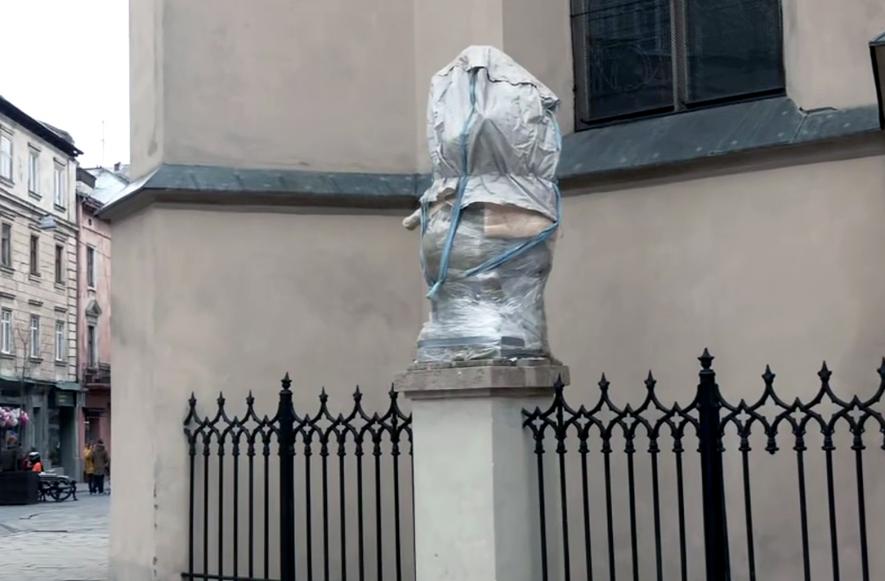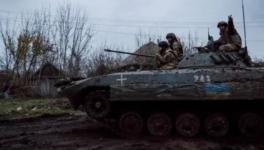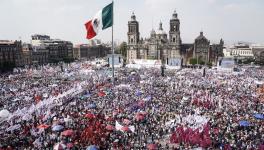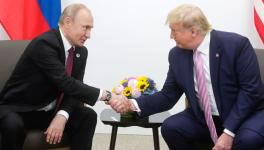A Possible Political-Diplomatic Solution to the Ukraine Conflict

Lviv, Mar 06 (ANI): A view of a covered statue amid the Russia-Ukraine crisis at Rynok Square, in Lviv on Sunday.
The seeds of the ongoing conflict in Ukraine were sown in 1991, after the dissolution of the Soviet Union. Since then, Ukraine has been a disarticulated country with contending national projects that draw “inspiration”, by and large, from the ruling elites of different foreign powers, principally the United States of America (USA) and Russia. For instance, the Zelensky administration is not an authentic representative of even the entirety of the predatory elites in Ukraine, leave alone the rest of the country’s people. These circumstances have been conducive to the ascendancy and entrenchment of the neo-liberal project in Ukraine, with all its attendant deleterious consequences in the form of attacks on workers’ rights, which have resulted in poverty and inequality, emigration and war.
Even before 2014, Ukraine was a very poor country in Europe due to growing neoliberalism. Further, the large-scale destruction that began in Ukraine in 2014, and has magnified during the current armed conflict, needs to be immediately halted to stop further ruination. Therefore, finding an immediate political-diplomatic solution to this conflict is of utmost importance.
Before the outbreak of the conflict in February, the USA rebuffed the political-diplomatic overtures of the Russian Federation’s government. The Zelensky administration, beholden to the United States government, lacked effective agency in this negotiation process and its eventual outcome. Previously, European countries such as Germany and France, which wanted to avoid war, did not have adequate strategic autonomy with respect to the United States to give effect to their policy of averting war.
The ongoing conflict is primarily a proxy war between USA and Russia, which has also become a civil war within Ukraine. Prolonging this armed conflict is likely to have devastating consequences for the people of Ukraine. Besides, extending the economic war on Russia will aggravate the travails of the world economy, which is already severely damaged by the Covid-19 pandemic. In particular, the world food crisis could intensify, creating the threat of famine and malnutrition that could affect millions, especially in developing countries. For these reasons, too, a political-diplomatic solution is required to resolve the varied dimensions of the Ukraine conflict.
The principal hurdle to a political-diplomatic solution is the role of the United States government. It tends to believe, incorrectly, that it possesses adequate strategic resources to practice dual containment with respect to both China and Russia. One result of this failed strategy is the growing strategic concord between China and Russia. Such concord puts paid to the hopes of the United States government of a political collapse in Russia (which it vainly hoped would follow the economic war on Russia). Therefore, the American elites’ expectation that they could end the Ukraine armed conflict on terms they find acceptable cannot be fulfilled.
The negotiation package the Russian Federation government and the Zelensky administration discussed in Istanbul, Turkiye, over March and April is now politically obsolete. The Zelensky administration unilaterally withdrew from these negotiations at the instance of the United States government. That package involved three elements: neutral status for Ukraine with “security guarantees”; Ukraine’s willy-nilly recognition of Russian sovereignty over Crimea; and an equally willy-nilly recognition by Ukraine of the “independence” of Donbas.
The incorporation—piloted by the USA—of hitherto ostensibly neutral Finland and Sweden into the North Atlantic Treaty Organisation (NATO) has also contributed to the political obsoleteness of the first point in the negotiation package (Ukraine’s neutral status). In these circumstances, the Russian Federation government is likely to be unwilling to accept merely written assurances about neutral status. In fact, the Russian Federation government has moved one step further and said it would not accept Ukraine’s accession to the European Union.
Recently, the Zelensky administration argued that the provision of weapons to Ukrainian armed forces (by the United States government) would help it achieve a “respectable” position during eventual negotiations with the Russian Federation government. The United States government (which now claims it no longer seeks to engineer a political collapse in Russia) has reiterated this. But such an argument is based on a fundamental misreading of the military balance and course of the Ukraine conflict so far. If the United States government supplies weapons that the Zelensky administration uses to attack targets within the Russian Federation territory, the consequent retaliatory measures of the Russian government may not be confined to Ukrainian territory. Further, to try and prevent the transfer of weapons, the Russian armed forces may escalate attacks on infrastructure within Ukraine. Therefore, the only available rational course is the recourse to a political-diplomatic solution.
In these circumstances, what could the contours of a viable political-diplomatic solution to the conflict in Ukraine look like?
First, Ukraine should become a neutral country with no membership of any military organisation (namely, NATO or the Collective Security Treaty Organisation) and disavow membership of the European Union and the Eurasian Economic Union.
Second, the neutrality of Ukraine should be guaranteed by placing joint military garrisons of the Russian Federation armed forces on the one hand and the armed forces of France (acting independently of the command of the United States through NATO) in mutually-agreed locations in Ukraine. No other country’s armed forces should be stationed in Ukraine (especially not those of the USA, England and Eastern Europe countries, since they operate at different levels within the framework of the “rules-based international order”). For instance, the armed forces of Germany and Italy cannot be part of this process for “historical reasons”. These garrisons will be tasked with maintaining peace and guaranteeing the security of Ukraine through mutually “restraining” moves. The Russian and French troops must not intervene in the domestic political process in Ukraine. Their joint troop presence may go some way in achieving the goal of non-interference of external powers in Ukraine’s domestic affairs.
Some voices in Russia are advocating for using peacekeepers from the Collective Security Treaty Organisation in Ukraine once the armed conflict ends. If negotiations are carried out with the intent to achieve sustainable peace, an agreement somewhat along the lines advocated in this article could be reached.
Third, both Crimea and Donbas must be made available to the citizens of Ukraine for visa-free travel and economic activities on a “national basis” and vice-versa.
Fourth, Ukraine should be reconstituted as a confederation of oblasts with the option to avail full autonomy. This is possibly the only means available to reconcile, to some extent, Ukrainian sovereignty over oblasts such as Mykolaiv/Nikolayev, Kherson, Kharkiv/Kharkhov, Zaporizhzhia/Zaporozhye etc., and the Russian presence therein. Similar considerations may apply to other oblasts in Ukraine if the Russian presence expands due to the prolongation of the armed conflict.
Fifth, the rebuilding of Ukraine should be fully financed, in mutually-agreed proportions, by all foreign countries willing to participate in the reconstruction process.
Sixth, along with this diplomatic solution, the repatriation of all Ukrainian refugees willing to return must be facilitated in tandem with United Nations organisations that have such responsibilities.
Seventh, the economic war against Russia must be fully reversed.
This seven-point solution that spans diplomacy and inclusive reconstruction has the potential to meet the basic requirements of all direct and indirect participants in the conflict in Ukraine. If implemented, it could preserve the sovereignty of Ukraine, meet the aspirations of people in Crimea and Donbas, address the security concerns of the Russian Federation’s government, alleviate the world food crisis and go some way to help European countries regain their strategic autonomy. It may also not be seen as a “climb down” for any of the parties to the conflict. And it could create conditions that could germinate an alternative to the neo-liberal project in Ukraine, which would require additional steps such as unbanning the Communist Party of Ukraine and reversing the ongoing attacks on workers’ rights.
It is an opportune time for all interested in peace and cooperation, the Left in particular, in Ukraine, Russia, Europe and the rest of the world, to advance the prospects for a political-diplomatic solution to the conflict in Ukraine. If this effort for peace succeeds, it will set a valuable precedent for resolving other ongoing armed conflicts in the world. The persistence of the conflict in Ukraine is conducive to the hegemony of the neo-liberal project, albeit in varying shades, in countries worldwide. Therefore, a political-diplomatic solution to the Ukraine conflict can initiate a process that challenges the neo-liberal project around the world.
The author is a professor at the Department of Economics, Satyawati College, University of Delhi. He thanks Dr Navpreet Kaur, Dr Radhika Menon and Prof Shaswati Mazumdar for critical interventions in a previous version of this article. The views expressed are personal.
Get the latest reports & analysis with people's perspective on Protests, movements & deep analytical videos, discussions of the current affairs in your Telegram app. Subscribe to NewsClick's Telegram channel & get Real-Time updates on stories, as they get published on our website.
























